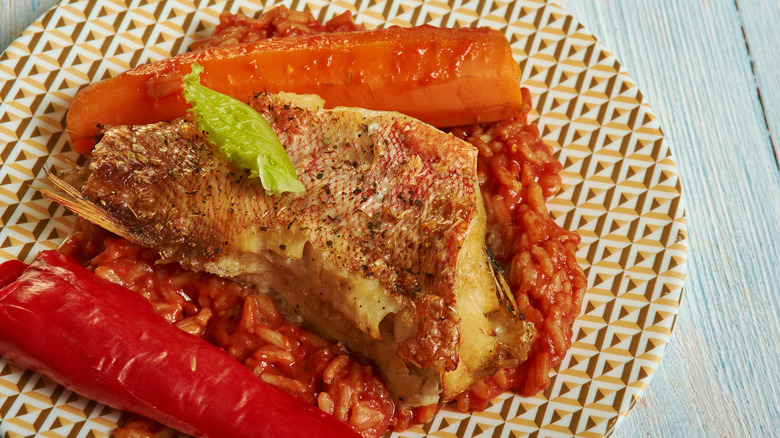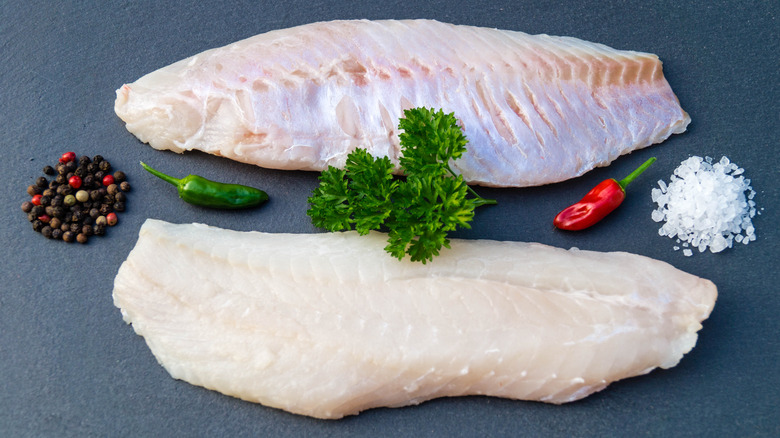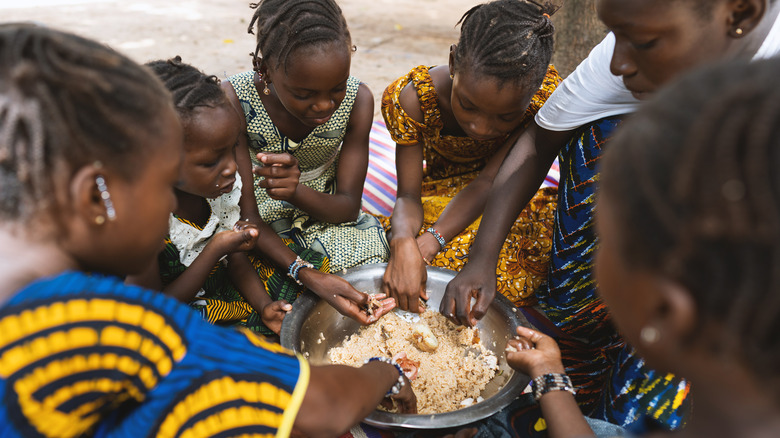What Makes Senegal's National Dish Thiéboudienne Unique?
Rice, vegetables, and sauce with a whole lot of heat. When combined together, this culinary trifecta encapsulates the one-pot wonders of Senegalese cuisine. Variations of this hearty meal branch out to the likes of chep bu jen (broiled fish with tomato sauce and veggies) and yassa (white rice with baked chicken or fish).
Don't let the simplicity of the above dishes deceive you, though. Senegal is known for incorporating a myriad of flavor profiles, such as brightness from limes and tomatoes, creaminess from black-eyed beans, nuttiness from peanuts, and comfort from broken rice and cassavas, via SBS. Seafood is also wildly popular since part of the country borders the Atlantic Ocean. To that, you're likely to find fish balls, as well as fish that's been either grilled, smoked, or dried, per Afro Culture. (It's worth noting that some dishes may also highlight mutton, sheep meatballs, or beef.)
Keeping with the seafood theme, though, there's one dish, in particular, that's so beloved that it's named the national dish of Senegal. It's called thiéboudienne, and according to Food of Africa, you'll be treated to lots of broken rice, vegetables, fish, tomato sauce, spices, and maybe even some fermented snails (via Atlas Obscura). The dish is said to have a rather time-consuming process, as several steps require love, attention, and flavor-building, as told by The Local Palate. Here's some more insight into thiéboudienne and why it's so special.
History of thiéboudienne
The translated version of thiéboudienne is "the rice of fish" (per African Food Network), and the dish seems to originate from the mind of Penda Mbaye. Terminology Coordination explains that she was a cook in Guet Ndar, Saint-Louis, who prepared some rather tasty fish rice. One day, a governor, who seemed to be impressed by her cooking, decided to hire her for ceremonial events. She then expanded her culinary knowledge using mashed cherry tomatoes (via 196 Flavors), which helped to add fresh flavors and vivid colors to her rice dishes.
Speaking of rice, during the 19th century, the French brought broken Vietnamese rice from Asia to Senegal, which became known as broken rice. Mbaye substituted this for barley, and to this day, many thiéboudienne recipes still feature broken rice (specifically, broken jasmine rice) (via Yummy Medley).
Mbaye's efforts were certainly not in vain, for thiéboudienne is incredibly popular around lunchtime in Senegal. You can find consumers with vessels of rice and stew at any to-go spot. Employees of shops seem to halt the busyness of their day to enjoy the dish with each other. And, of course, many households in the country participate in the communal experience of thiéboudienne as well.
Now that the dish's origins have been discussed, it's time to get cooking!
How to make thiéboudienne
The first thing to do is stuff the fish fillets, which, ideally, should be snapper or grouper (though Food of Africa insists that you can use any kind of fish). Saveur explains that parsley, red chile flakes, onions, garlic, scallions (these last three should be minced), and salt and pepper should be mixed and then placed inside the fish fillets. Use a paring knife to make 2-inch slits.
Add chopped onions and green bell pepper(s) to a Dutch oven coated in canola or palm oil. These are sautéed over medium heat. Tomato paste is added, followed by vegetable or fish stock. Saveur recommends using mashed tomatoes and bay leaves for more flavor.
After the mixture is boiled, lower the heat. Place the stuffed fish fillets inside the Dutch oven to cook for 18 minutes. When they're done, take them out, and put them on a plate.
At this point, International Cuisine mentions that the following vegetables should be incorporated: eggplant, cabbage, carrots, and sweet potatoes. Turnips and cassava are also popular additions. When these veggies are finally cooked, place them in a bowl. Finally, add okra and several cups of hot water. Wait for five minutes, then take the okra out.
Now just mix in the rice and let everything cook for another 45 minutes on low heat, and voilà! You're done!
How to eat thiéboudienne
If you want to make the people of Senegal proud, use your hands to dine on thiéboudienne. As Morgane Recipes explains on their YouTube channel, rice is first scooped onto a plate, followed by the vegetables and fish fillets. This plate usually serves as a centerpiece, and according to Matador Network, the fun begins when guests dig into the dish without any utensils involved. Using your hands, just pick up as much rice, fish, and veggies as you can and enjoy.
Alternatively, you can use a plate with utensils for a less messy experience, as noted by the above YouTube channel. The plate of thiéboudienne still serves as the centerpiece, but this time, everyone helps themselves by scooping some of the food onto their plate. Fresh lime wedges are also served on the side for an extra boost of acidity and brightness.
So what makes thiéboudienne unique? Is it the unison of flavorful vegetables, meaty fish, and broken rice? Or is it the communal experience of eating this dish with friends, family, and maybe even some locals of Senegal? The answer is, of course, both, and in the future, we're certain that people worldwide will learn about and enjoy the best dish that Penda Mbaye helped to create.



